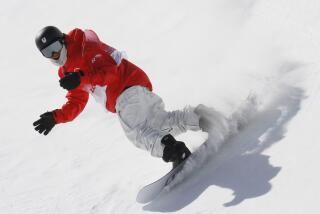It may be cold but drink up
- Share via
Ever wonder why an outdoor workout in cooler weather doesn’t leave you gasping for the water bottle nearly as much as a similar summer exertion? Well, sidle up to the water filter and draw yourself a tall, cool one, folks. It’s biology lesson time.
First: Your body loses, and needs to have replenished, just as much fluid when it’s cold outside as it does in the heat. You sweat just as much in the cold, but the dry air laps up the moisture before it can pool on your skin. The only difference is that you feel less thirsty in the cold, and that can be dangerous.
Why the repressed thirst? When your body senses cold air, blood vessels constrict, pushing blood to the body’s core to preserve heat, explains Robert Kenefick, associate professor of exercise science at the University of New Hampshire.
“If your body kept that heat near the skin when there was a big temperature differential between the air and your body, you would lose heat quickly to the environment,” said Kenefick, whose study on cold, hydration and thirst was published in the September issue of the journal Medicine & Science in Sports & Exercise.
The blood concentration inadvertently fools your thirst-regulating mechanism into thinking that the body has ample fluids. Your hypothalamus, sensing all that blood in your belly, thinks you have plenty of juice. So: No call for the beverage cart.
Kenefick and colleagues studied 17 men, ages 20 to 37, who were tested after exercising at an ambient temperature of 39 degrees and after working out at 81 degrees. All were also tested at rest.
When exposed to cold, all participants exhibited less thirst than they did at the warmer temperatures. This occurred whether or not they were exercising and whether or not they were previously dehydrated.
Kenefick said he was unsure at precisely what temperature the effect would kick in, but suspected it would be about 40 degrees. The response is probably the same in women, he said.
“The thirst mechanism in humans is fairly poor compared to other animals,” Kenefick said.
He cites research that shows people who had lost 2% of their body weight through dehydration before exercise experienced abnormally elevated heart rates, high body temperatures and decreases in strength and endurance. Symptoms of dehydration include headache, dizziness and dark urine.
So, despite a lack of thirst, do the same things you’d do in warmer weather: Shoot for 17 to 20 ounces of water about two hours before exercise and, if possible, 5 to 10 ounces every 15 to 20 minutes during exercise. Afterward, drink 24 ounces for every pound of lost body weight.
For particularly long or intense exercise bouts, drink a sports drink or other electrolyte-containing fluid to reduce the risk of overhydration (hyponatremia), a serious condition in which blood sodium content drops to dangerous levels.




